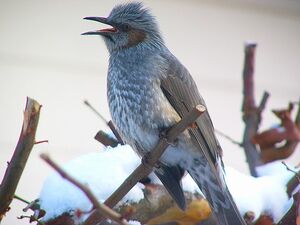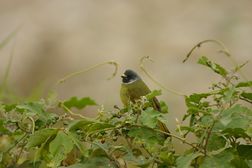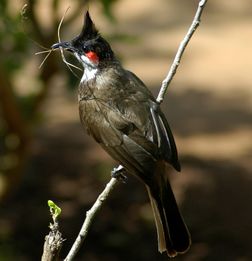بلبل
| بلبل | |
|---|---|

| |
| Brown-eared bulbul (Hypsipetes amaurotis) | |
| التصنيف العلمي | |
| أصنوفة غير معروفة (أصلحها): | Pycnonotidae |
| Genera | |
|
See text | |
| Synonyms | |
| |
البلبل Bulbul هو عصفور مغرد صغير ومن فصيلة Pycnonotidae, of medium-sized passerine songbirds, which also includes greenbuls, brownbuls, leafloves, and bristlebills. The family is distributed across most of Africa and into the Middle East, tropical Asia to Indonesia, and north as far as Japan. A few insular species occur on the tropical islands of the Indian Ocean. There are 160 species in 32 genera. While different species are found in a wide range of habitats, the African species are predominantly found in rainforest, whereas Asian bulbuls are predominantly found in more open areas.
. . . . . . . . . . . . . . . . . . . . . . . . . . . . . . . . . . . . . . . . . . . . . . . . . . . . . . . . . . . . . . . . . . . . . . . . . . . . . . . . . . . . . . . . . . . . . . . . . . . . . . . . . . . . . . . . . . . . . . . . . . . . . . . . . . . . . . . . . . . . . . . . . . . . . . . . . . . . . . . . . . . . . . . .
التبويب
| ||||||||||||||||||||||||||||||||||||||||||||||||
| Phylogeny based on a study of the babblers by Cai and colleagues published in 2019.[1][2] |
قائمة الأجناس
Currently, there are 160 recognized species in 32 genera:[1]
- Genus Andropadus – sombre greenbul (formerly contained many species)
- Genus Stelgidillas – slender-billed greenbul (formerly in Andropadus)
- Genus Calyptocichla – golden greenbul
- Genus Neolestes – black-collared bulbul
- Genus Bleda – bristlebills (5 species)
- Genus Atimastillas – yellow-throated leaflove
- Genus Ixonotus – spotted greenbul
- Genus Thescelocichla – swamp palm bulbul
- Genus Chlorocichla – greenbuls (5 species)
- Genus Baeopogon – greenbuls (2 species)
- Genus Arizelocichla – greenbuls (12 species) (formerly in Andropadus)
- Genus Criniger – greenbuls (5 species)
- Genus Eurillas – greenbuls (5 species) (formerly in Andropadus)
- Genus Phyllastrephus – greenbuls and brownbuls (20 species)
- Genus Tricholestes – hairy-backed bulbul
- Genus Setornis – hook-billed bulbul
- Genus Alophoixus – 8 species (formerly in Criniger)
- Genus Alcurus – 2 species (formerly in Pycnonotus)
- Genus Iole – 7 species
- Genus Hemixos – 4 species
- Genus Acritillas – yellow-browed bulbul
- Genus Ixos – 5 species
- Genus Hypsipetes – 19 species (includes 3 species formerly in Thapsinillas, one formerly in Cerasophila and one formerly in Microscelis)
- Genus Euptilotus – puff-backed bulbul (formerly in Pycnonotus)
- Genus Microtarsus – black-and-white bulbul (formerly in Pycnonotus)
- Genus Poliolophus – yellow-wattled bulbul (formerly in Pycnonotus)
- Genus Brachypodius – 4 species (formerly in Pycnonotus)
- Genus Ixodia – 3 species (formerly in Pycnonotus)
- Genus Rubigula – 5 species (formerly in Pycnonotus)
- Genus Nok – bare-faced bulbul (genus introduced in 2017)
- Genus Spizixos – finchbills (2 species)
- Genus Pycnonotus – 32 species (substantially reduced from earlier classification)
Cladogram
|
| ||||||||||||||||||||||||||||||||||||||||||||||||||||||||||||||||||||||||||||||||||||||||||||||||||||||||||||||||||||||||||||||||||||||||||||||||||||||||||||||||||||||||||||||||||||||||||||||||||||||||||||
| Phylogeny based on a study by Subir Shakya and Frederick Shelden published in 2017 with the revised genera as defined in the list maintained on behalf of the International Ornithological Committee.[1][3] The positions of the bare-faced bulbul (Nok hualon) and the yellow-browed bulbul (Acritillas indica) are based on a study by Jérôme Fuchs and colleagues published in 2018.[4] As currently defined the genera Chlorocichla and Arizelocichla are not monophyletic. |
. . . . . . . . . . . . . . . . . . . . . . . . . . . . . . . . . . . . . . . . . . . . . . . . . . . . . . . . . . . . . . . . . . . . . . . . . . . . . . . . . . . . . . . . . . . . . . . . . . . . . . . . . . . . . . . . . . . . . . . . . . . . . . . . . . . . . . . . . . . . . . . . . . . . . . . . . . . . . . . . . . . . . . . .
الوصف
طول جسمه يتراوح بين 15 إلى 16.5 سم وهو ذو بطن لونه بني فاتح او رمادي, ظهره بني وذنبه بني يميل إلى الحمرة.
هو يعيش في التشققات الموجودة في الابنية. ويقوم ببناء عشه من القش. وتبيض انثاه العديد من البيض. ويتغذى على الحشرات كالديدان والحبوب.
صوت الذكر مشهور جدا وعال وتنوع من التصفيرات خاصة في موسم التكاثر. بالرغم من انه يغني طول النهار, فهو يغني بصورة غير عادية بالمساء والليل وصوته يكون بارزا لان قليلاً من العصافير تلك التي تغني في مثل هذا الوقت.
تشير الابحاث الاخيرة إلى ان العصافير تغني بصوت اقوى في المناطق المسكونة وخاصة المدن اكثر من غيرها وذلك حتى تتغلب على الضجة.
Bulbuls are short-necked slender passerines. The tails are long and the wings short and rounded. In almost all species the bill is slightly elongated and slightly hooked at the end. They vary in length from 13 cm and 13.3 g (0.47 oz) for the tiny greenbul to 29 cm and 93 g (3.3 oz) in the straw-headed bulbul.[5] Overall the sexes are alike, although the females tend to be slightly smaller. In a few species the differences are so great that they have been described as functionally different species. The soft plumage of some species is colorful with yellow, red or orange vents, cheeks, throat or supercilia, but most are drab, with uniform olive-brown to black plumage. Species with dull coloured eyes often sport contrasting eyerings. Some have very distinct crests. Bulbuls are highly vocal, with the calls of most species being described as nasal or gravelly. One author described the song of the brown-eared bulbul as "one of the most unattractive noises made by any bird".[6]
السلوك والبيئة
التهجين
The bulbuls are generally monogamous. One unusual exception is the yellow-whiskered greenbul which at least over part of its range appears to be polygamous and engage in a lekking system. Some species also have alloparenting arrangements, where non-breeders, usually the young from earlier clutches, help raise the young of a dominant breeding pair.[7] Up to five speckled eggs are laid in open tree nests and incubated by the female. Incubation usually lasts between 11 and 14 days, and chicks fledge after 12–16 days.[8]
الغذاء
Bulbuls eat a wide range of foods, ranging from fruit to seeds, nectar, small insects and other arthropods and even small vertebrates. The majority of species are frugivorous and supplement their diet with some insects, although there is a significant minority of specialists, particularly in Africa. Open country species in particular are generalists. Bulbuls in the genus Criniger and bristlebills in the genus Bleda will join mixed-species feeding flocks.
العلاقة بالبشر
The red-whiskered bulbuls and red-vented bulbuls have been captured for the pet trade in great numbers and have been widely introduced to tropical and subtropical areas, for example, southern Florida, Fiji, Australia and Hawaii. Some species[which?] are regarded as crop pests, particularly in orchards.[بحاجة لمصدر]
In general, bulbuls and greenbuls are resistant to human pressures on the environment and are tolerant of disturbed habitat. Around 13 species are considered threatened by human activities, mostly specialised forest species that are threatened by habitat loss.
المراجع
- ^ أ ب ت Gill, Frank; Donsker, David; Rasmussen, Pamela, eds. (July 2021). "Bulbuls". IOC World Bird List Version 11.2. International Ornithologists' Union. Retrieved 9 December 2021.
- ^ Cai, T.; Cibois, A.; Alström, P.; Moyle, R.G.; Kennedy, J.D.; Shao, S.; Zhang, R.; Irestedt, M.; Ericson, P.G.P.; Gelang, M.; Qu, Y.; Lei, F.; Fjeldså, J. (2019). "Near-complete phylogeny and taxonomic revision of the world's babblers (Aves: Passeriformes)". Molecular Phylogenetics and Evolution. 130: 346–356. doi:10.1016/j.ympev.2018.10.010. PMID 30321696.
- ^ خطأ استشهاد: وسم
<ref>غير صحيح؛ لا نص تم توفيره للمراجع المسماةshakya - ^ Fuchs, J.; Pasquet, E.; Stuart, B.L.; Woxvold, I.A.; Duckworth, J.W.; Bowie, R.C.K. (2018). "Phylogenetic affinities of the enigmatic Bare-faced Bulbul Pycnonotus hualon with description of a new genus". Ibis. 160 (3): 659–665. doi:10.1111/ibi.12580.
- ^ Dunning, John B. Jr., ed. (2008). CRC Handbook of Avian Body Masses (2nd ed.). CRC Press. ISBN 978-1-4200-6444-5.
- ^ Fishpool & Tobias 2005, p. 146.
- ^ Fishpool & Tobias 2005, p. 151.
- ^ Fishpool & Tobias 2005, pp. 154–155.
المصادر
- Fishpool, L.D.C.; Tobias, J.A. (2005). "Family Pycnonotidae (Bulbuls)". In del Hoyo, J.; Elliott, A.; Christie, D.A. (eds.). Handbook of the Birds of the World. Vol. 10: Cuckoo-shrikes to Thrushes. Barcelona, Spain: Lynx Edicions. pp. 124–250. ISBN 978-84-87334-72-6.
وصلات خارجية
- Bulbul photos and videos on the Internet Bird Collection
- Family characters


